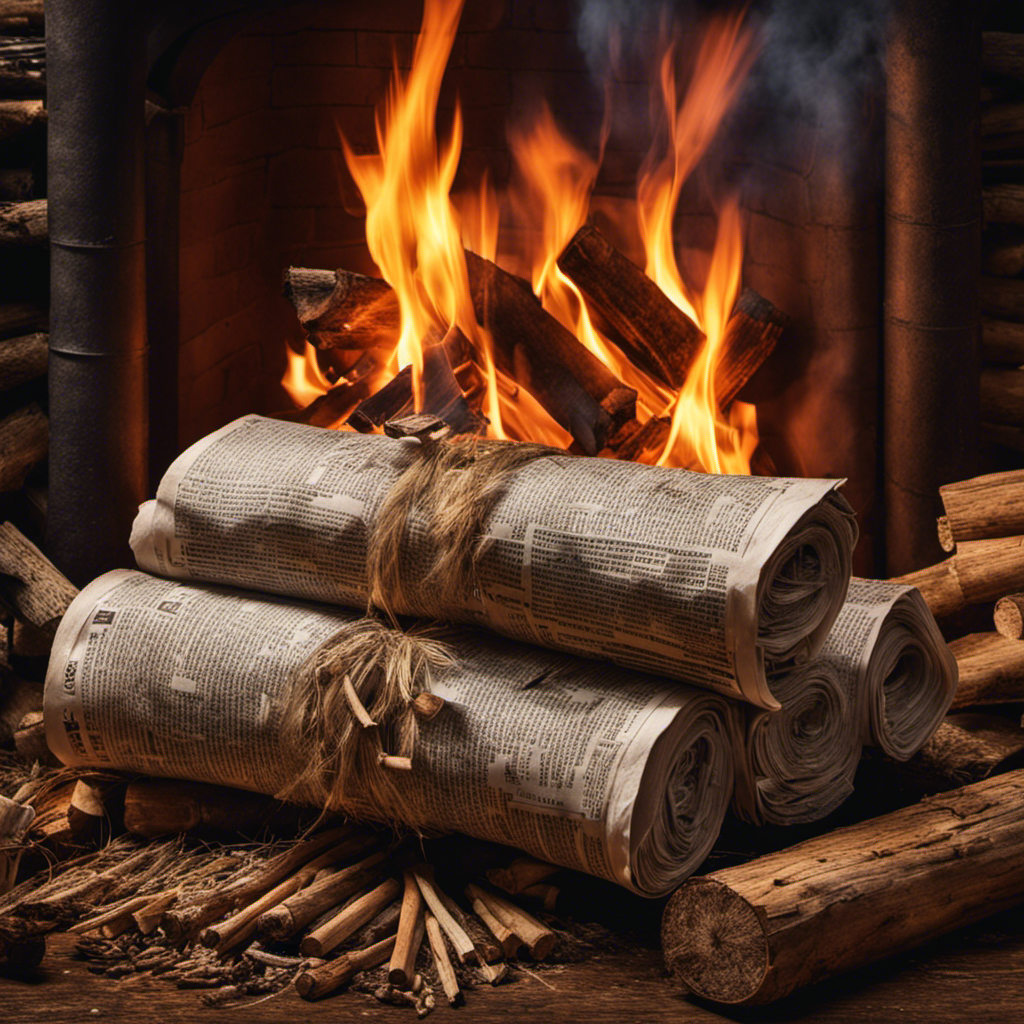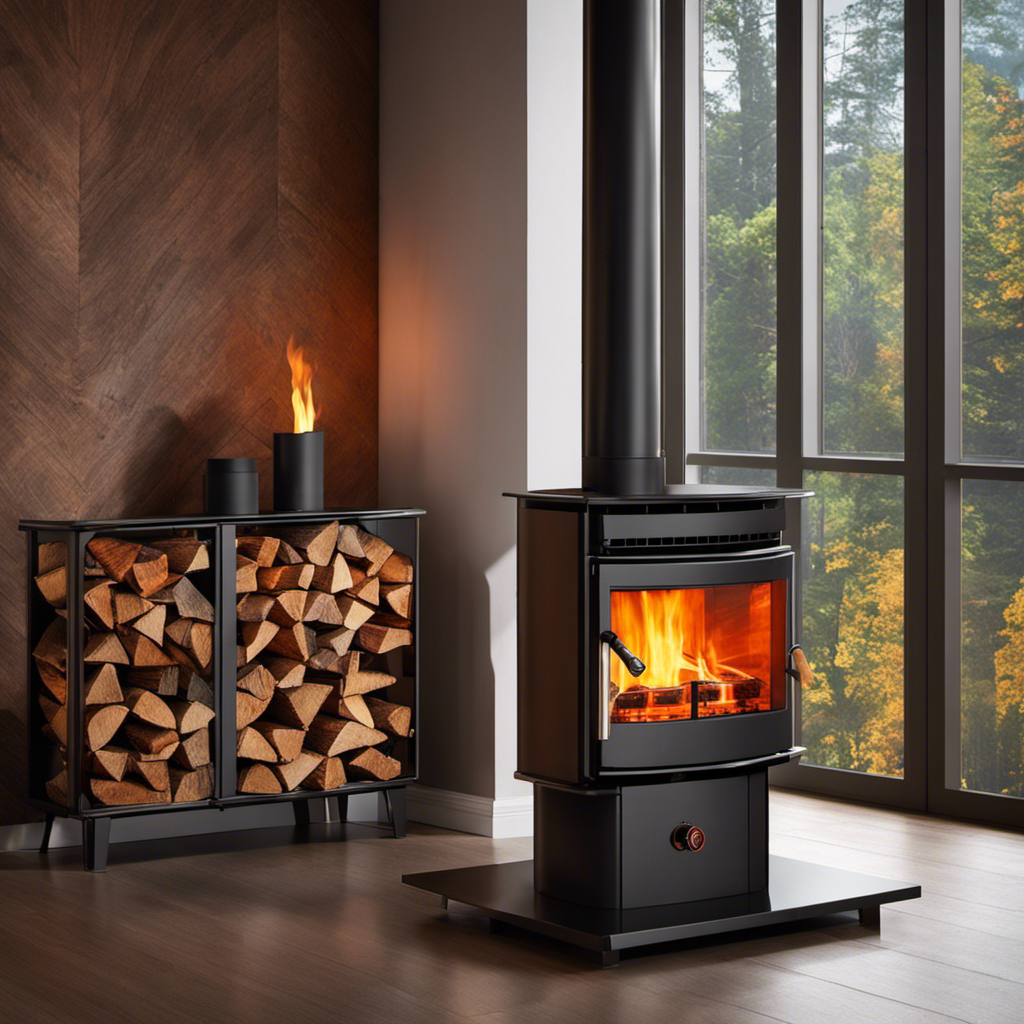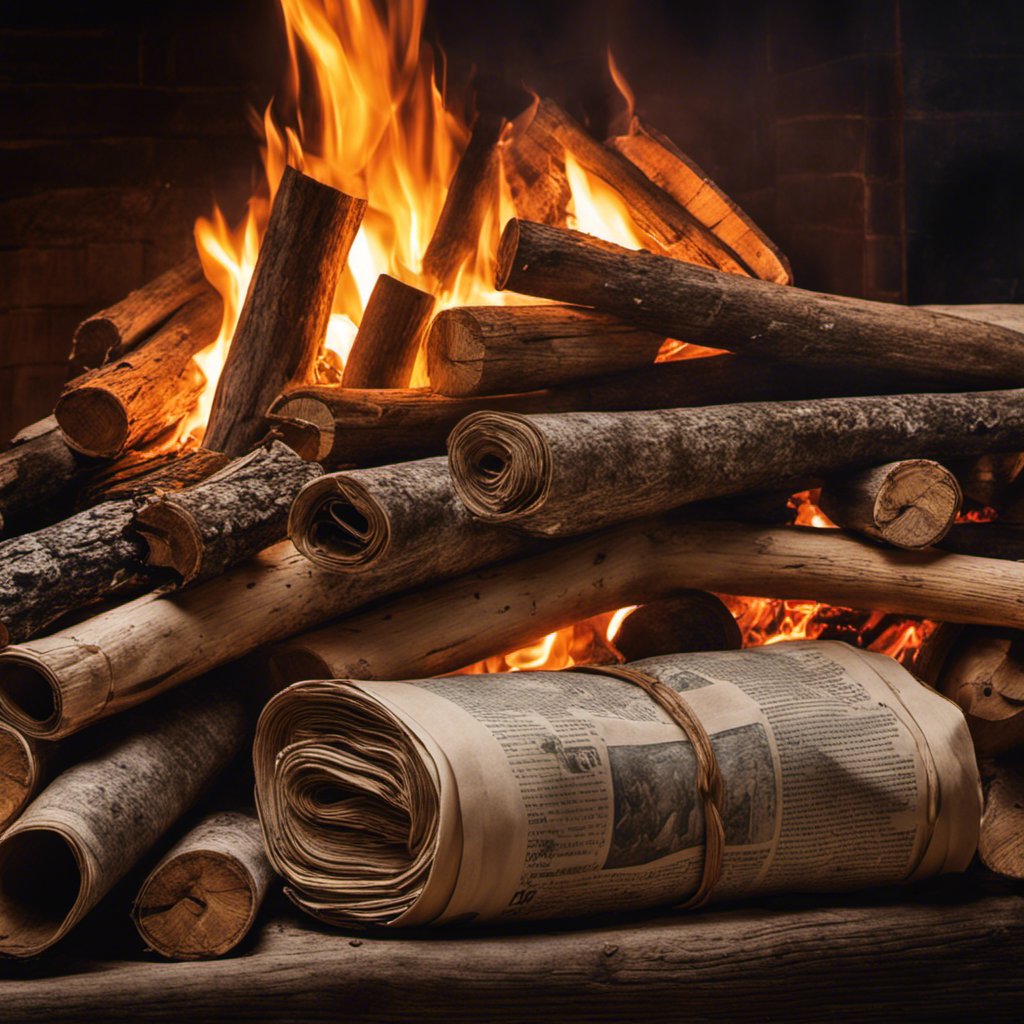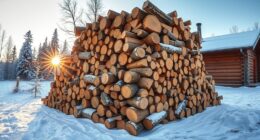I understand starting a fire in a wood stove can appear daunting, however, I assure you, it’s easier than it seems. By following a few easy steps and gathering the necessary materials, you’ll have a warm fire going in no time.
In this article, I’ll guide you through the process of understanding your wood stove, gathering materials, preparing the firebox, building the perfect fire, lighting it up, and safely maintaining it.
Get ready to enjoy the warmth and ambiance of your wood stove like a pro.
Key Takeaways
- Familiarize yourself with the different components and functions of your wood stove.
- Regularly clean the stove to remove creosote and ash buildup.
- Store firewood in a dry and protected area, and season it for 6-12 months to reduce moisture content.
- Properly prepare kindling and arrange firewood in a crisscross pattern for better combustion.
Understanding Your Wood Stove
I really enjoy learning about the different components and functions of my wood stove. It’s fascinating how this simple appliance can efficiently heat my home during the cold winter months. Understanding your wood stove is crucial for proper maintenance and troubleshooting common issues. By familiarizing yourself with its various parts and how they work together, you can ensure its optimal performance.
One essential aspect of wood stove maintenance is regular cleaning. Over time, creosote and ash can accumulate inside the stove, reducing its efficiency and posing a fire hazard. By regularly removing these deposits, you can prevent blockages and ensure a clean burn.
Another important maintenance task is inspecting the door gasket. This seal prevents air leaks and ensures proper combustion. If you notice any signs of wear or damage, it’s essential to replace the gasket promptly to maintain the stove’s efficiency.
Troubleshooting common issues with your wood stove can save you time and money. If you’re experiencing difficulty in starting a fire, check for proper airflow. Ensure that the air vents are open and that the chimney isn’t blocked.
Understanding your wood stove and performing regular maintenance won’t only extend its lifespan but also ensure its efficient operation. By troubleshooting common issues and addressing them promptly, you can enjoy a warm and cozy home throughout the winter.
Gathering the Necessary Materials
To get ready to light it, I just need to gather the firewood and kindling. Firewood is an essential component of starting a wood stove, and proper storage and seasoning are crucial for a successful fire.
When it comes to firewood storage, it’s important to keep it dry and protected from the elements. A shed or a covered storage area is ideal, as it prevents moisture from seeping into the wood. Additionally, firewood should be stacked off the ground to allow air circulation and prevent rotting.
Firewood seasoning is the process of drying the wood to reduce its moisture content. Freshly cut wood typically has a high moisture content, which makes it difficult to burn efficiently. To season firewood, it should be split and stacked in a well-ventilated area. This allows air to circulate around the wood, speeding up the drying process. It’s important to note that firewood takes time to season properly, usually around 6-12 months, depending on the type of wood.
Preparing the Firebox
Once the firewood and kindling are gathered, I carefully arrange them in the firebox for a well-balanced and efficient fire. The firebox is a crucial component of a wood stove, as it’s where the fire burns and heat is generated. Proper firebox maintenance and cleaning are essential to ensure optimal performance and safety.
Here are three important steps to prepare the firebox:
-
Remove any ashes: Before starting a new fire, it’s important to clean out any remaining ashes from the previous burn. Use a small shovel or ash scoop to carefully scoop out the ashes and dispose of them in a metal container. This will help improve airflow and prevent the buildup of creosote.
-
Inspect the firebox: Take a close look at the firebox to check for any signs of damage or wear. Look for cracks, rust, or loose bricks, and address any issues promptly to prevent further damage. Regular inspection and maintenance will ensure the longevity of your wood stove.
-
Clean the firebox walls: Over time, a layer of soot and creosote can accumulate on the walls of the firebox. Use a stiff brush or a wire brush attachment on a drill to scrub away the buildup. Be thorough but gentle to avoid damaging the firebox.
Building the Perfect Fire
Building a fire that burns efficiently and produces optimal heat is essential for a well-functioning wood stove. As an experienced wood stove user, I’ve learned various building techniques that can help you achieve the perfect fire every time while ensuring fire safety.
Firstly, it’s crucial to start with dry and seasoned firewood. Wet or green wood won’t burn efficiently and can lead to excessive smoke and creosote buildup in your stove.
Next, arrange the firewood in a crisscross pattern, leaving enough space for air circulation. This allows for better combustion and more even heat distribution.
To ignite the fire, use small pieces of kindling or newspaper in the center of the firebox. Avoid using flammable liquids or materials as they can be dangerous and cause unexpected flare-ups.
Once the fire is lit, gradually add larger pieces of firewood, ensuring that they’re positioned securely to prevent rolling or falling out of the stove.
Lastly, always prioritize fire safety. Keep a fire extinguisher nearby and never leave a fire unattended. Regularly clean the stove and chimney to prevent creosote buildup, which can lead to chimney fires.
Follow these building techniques and fire safety guidelines to enjoy a cozy and efficient wood stove experience.
Lighting the Fire
When it comes to lighting the fire, there are a few key steps to follow.
Firstly, proper kindling preparation is crucial to ensure a successful ignition.
Secondly, choosing the right fuel is important for maintaining a steady and efficient burn.
Lastly, mastering fire ventilation will allow you to control the heat output and keep the fire burning safely and effectively.
Proper Kindling Preparation
I always make sure to properly prepare my kindling before starting the wood stove. This step is crucial for ensuring a successful fire and efficient heating. Here are three key tips for properly preparing kindling:
-
Kindling Storage: It’s important to store your kindling in a dry place, away from moisture. Moist kindling can be difficult to ignite and may result in a smoky fire. I recommend using a designated kindling box or keeping it in a covered area.
-
Size Matters: Cut your kindling into small, thin pieces. This allows for better airflow and faster ignition. Aim for pieces that are about the thickness of your thumb. You can use a hatchet or a kindling splitter to get the right size.
-
Alternative Fire Starters: Sometimes, it can be challenging to get a fire going with just kindling. Consider using alternative fire starters like newspaper, cardboard, or firelighters. These can provide an extra boost of heat and help ignite the kindling more easily.
Choosing the Right Fuel
When it comes to choosing the right fuel for your wood stove, there are several options to consider. Each fuel has its own characteristics and benefits, so it’s important to find the one that suits your needs. Here are some common fuel options and their storage solutions:
| Fuel Option | Characteristics | Storage Solution |
|---|---|---|
| Firewood | Provides long-lasting heat and cozy ambiance. | Store in a dry, well-ventilated area to prevent moisture and pests. |
| Pellets | Highly efficient and easy to store. | Keep in airtight containers or bags to maintain their quality. |
| Coal | Generates intense heat and burns for a long time. | Store in a cool, dry place away from flammable materials. |
Mastering Fire Ventilation
Mastering fire ventilation is crucial for ensuring that the wood stove operates efficiently and safely. Proper ventilation helps maintain a clean and healthy environment inside your home, while also preventing potential fire hazards.
Here are three key tips for effective fire ventilation:
-
Open the damper: The damper is a device that controls the airflow in your wood stove. By fully opening the damper before starting the fire, you allow for proper oxygen supply, which helps the fire burn hotter and more efficiently.
-
Use the air controls: Most wood stoves come with air controls that allow you to regulate the amount of air entering the firebox. Adjusting these controls can help you achieve optimal combustion, reducing smoke and increasing heat output.
-
Monitor the smoke: Pay attention to the color and amount of smoke produced by the fire. Ideally, you want to see minimal smoke and a light grey or white color. Excessive smoke or dark, black smoke indicates poor ventilation and potential fire safety issues.
Maintaining and Controlling the Fire
To keep the fire burning steadily, I adjust the air intake and add small amounts of wood as needed. Fire maintenance is essential for the efficient and safe operation of a wood stove. Controlling the fire involves managing the air supply and fuel to ensure optimal heat output and minimize the risk of smoke or creosote buildup.
To maintain the fire, I start by opening the air intake fully to allow for maximum oxygen flow. This promotes a strong and vigorous fire. As the fire gets going, I gradually adjust the air intake to control the burn rate. Closing the intake slightly reduces the amount of oxygen, resulting in a slower burn and less heat output. Opening it wider increases the airflow and intensifies the flames.
Adding small amounts of wood at regular intervals helps to maintain a consistent burn. I avoid overloading the stove with too much wood, as this can smother the fire and reduce its efficiency. Instead, I add small amounts of seasoned wood to keep the fire going steadily.
By properly maintaining and controlling the fire, I ensure that my wood stove operates efficiently and effectively. This not only provides warmth but also helps to reduce the risk of chimney fires and other hazards.
Now, let’s move on to some important safety tips for wood stove use.
Safety Tips for Wood Stove Use
When it comes to using a wood stove, safety should always be a top priority. To ensure a safe and enjoyable experience, there are a few key tips to keep in mind.
Fire Hazard Prevention
I always make sure to keep a clear space around my wood stove to prevent any fire hazards. Fire prevention is crucial when it comes to using a wood stove, as a small mistake can lead to devastating consequences. Here are some safety measures I follow to minimize the risk of fire:
-
Regular chimney cleaning: I schedule professional chimney cleanings at least once a year to remove any built-up creosote, which can ignite and cause a chimney fire.
-
Proper ash disposal: I wait for the ashes to cool completely before disposing of them in a metal container with a tight-fitting lid. This prevents accidental fires from hot embers.
-
Use a fireproof hearth rug: I always place a fireproof rug in front of my wood stove to protect the floor from sparks or embers that may escape the stove.
Proper Ventilation Techniques
Proper ventilation is essential for maintaining a safe and efficient wood stove. When it comes to using a wood stove, ensuring proper ventilation has numerous benefits.
Firstly, it helps in maintaining good air quality by removing smoke, gases, and other pollutants from the room. This is particularly important for people with respiratory issues.
Additionally, proper ventilation prevents the buildup of carbon monoxide, a deadly gas that can be produced by the wood stove. Troubleshooting ventilation issues is crucial to ensure the stove functions optimally.
Common problems include a blocked chimney or flue, which can lead to poor airflow. Regularly cleaning and inspecting the ventilation system can prevent these issues and ensure the wood stove operates safely and effectively.
Frequently Asked Questions
How Often Should I Clean My Wood Stove?
I clean my wood stove every 3-6 months to ensure it’s functioning properly. Regular wood stove maintenance is crucial for optimal performance and safety.
Signs of a dirty wood stove include excessive smoke, weak flames, and a buildup of soot or creosote.
Cleaning involves removing ashes, scrubbing the stove’s interior, and inspecting the chimney. It’s important to follow the manufacturer’s guidelines and consult a professional if needed.
Regular cleaning will help prolong the lifespan of your wood stove.
Can I Burn Any Type of Wood in My Wood Stove?
Can I burn any type of wood in my wood stove?
Well, it’s important to know that not all types of firewood are created equal. Burning pine, for example, can be problematic due to its high resin content, which can lead to creosote buildup and potentially dangerous chimney fires.
It’s best to stick with hardwoods like oak or maple, which burn longer and produce more heat.
Always prioritize safety when choosing the right wood for your stove.
How Long Does It Take for the Wood Stove to Heat up a Room?
It typically takes around 30 minutes to an hour for a wood stove to heat up a room. However, this can vary depending on factors such as the size of the room, the insulation of the space, and the quality of the wood being burned.
To ensure efficient heating, it’s important to properly maintain your wood stove and use dry, seasoned wood. Regular cleaning and proper airflow management are key for effective wood stove usage.
Can I Leave the Wood Stove Unattended While It Is Burning?
I wouldn’t recommend leaving a wood stove unattended while it’s burning. Leaving a wood stove unattended can pose a fire hazard and increase the risk of accidents. It’s important to prioritize wood stove safety precautions and maintain regular wood stove maintenance. Always ensure that someone is present to monitor the stove and extinguish the fire if necessary. It’s better to be safe and attentive when it comes to wood stove usage.
Is It Safe to Use My Wood Stove During a Power Outage?
During a power outage, it’s generally safe to use a wood stove as an alternative heating option. However, it’s crucial to ensure that your wood stove is well-maintained and in good working condition.
Regular wood stove maintenance, such as cleaning the chimney and checking for any leaks or damage, is essential for safety. Remember to follow proper guidelines and precautions to prevent accidents.
Always prioritize safety when using a wood stove, especially during a power outage.
Conclusion
In conclusion, starting a wood stove requires understanding your stove, gathering necessary materials, preparing the firebox, building a perfect fire, lighting it, and maintaining and controlling the fire.
By following these steps and implementing safety tips, you can enjoy the warmth and ambiance of a wood stove while ensuring optimal performance and safety.
Remember, proper knowledge and attention to detail are key to successfully starting and using a wood stove.
Logan’s affair with adventure began in childhood. He hailed from a small town where vast forests bordered one side and endless shores stretched on the other. His days were spent exploring uncharted woods, climbing tall trees, or listening to the tales of old sailors. This early immersion in a world brimming with stories and mysteries became the foundation of his passion for writing.











